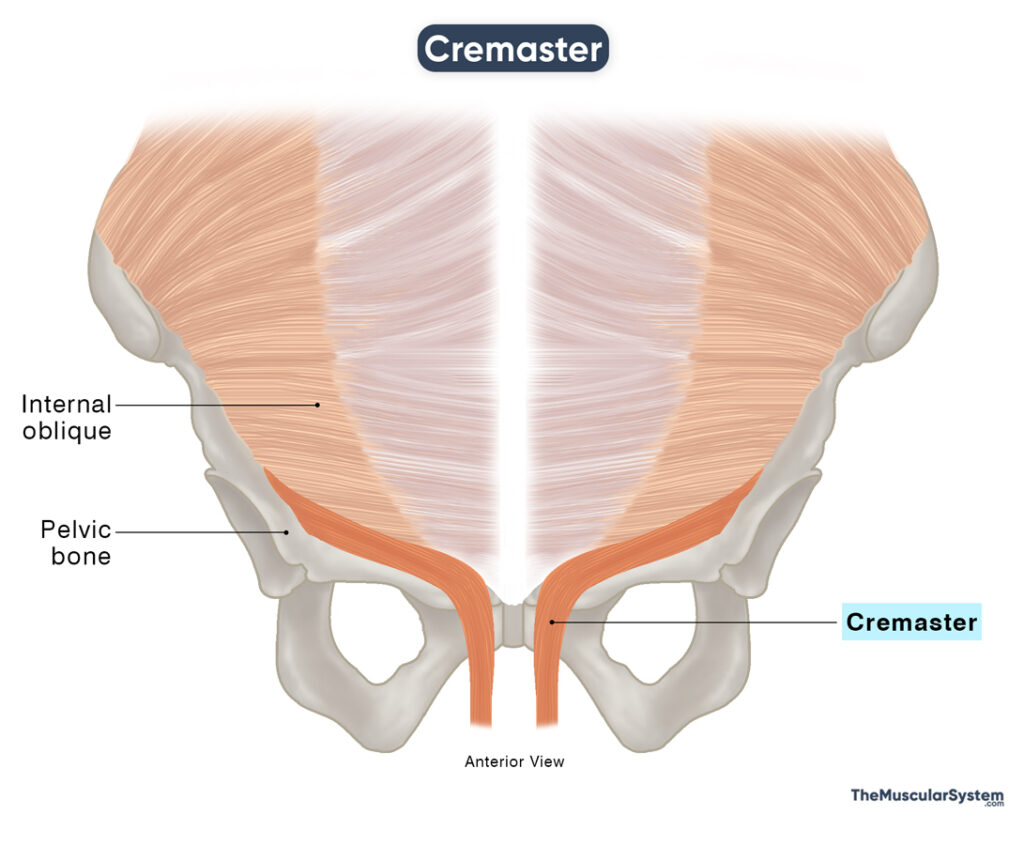Cremaster
Last updated:
22/05/2025Della Barnes, an MS Anatomy graduate, blends medical research with accessible writing, simplifying complex anatomy for a better understanding and appreciation of human anatomy.
What is the Cremaster
The cremaster is a paired muscle in the pelvis, fully developed only in males, covering the testicles and spermatic cord. Traditionally considered a purely skeletal muscle, more recent histological studies have revealed its unique composition, consisting of both smooth (involuntary) and striated (voluntary, skeletal) muscle fibers.
With this complex structure, the cremaster’s activity is primarily involuntary. It raises and lowers the testicles via the cremasteric reflex to regulate temperature and protect them from injury. However, its skeletal muscle components may allow limited voluntary control in some individuals, particularly during focused pelvic floor exercises such as Kegels.
Though the muscle does not develop fully in females, rudimentary cremaster fibers may still be present near the round ligament of the uterus.
Location and Attachments
| Origin | Inferior border of the internal oblique and the inguinal ligament |
| Insertion | Tunica vaginalis |
Origin
The muscle’s origin is divided into two parts.
The lateral part arises from the lower border of the abdominal internal oblique muscle and the mid to lower half of the inguinal ligament. Some fibers may also originate from the lower edge of the transversus abdominis muscle.
The medial part, which may be absent in some cases, originates from the pubic tubercle and the lateral side of the pubic crest.
Insertion
The lateral and medial parts merge and course downward. As they reach the scrotum, they create a network of muscular fascicles that ultimately insert into the lower surface of the tunica vaginalis, the membrane covering the testicles.
Relations With Surrounding Muscles and Structures
As the fibers of the cremaster descend from their point of origin, they enter the scrotum and merge with the surrounding connective tissues to form the cremasteric fascia, a thin muscular sheet that encloses the spermatic cord. The cremasteric fascia lies just deep to the external spermatic fascia, which is the outermost layer of the spermatic cord.
Function
| Action | Retracting the testicles to protect them |
The muscle is involved in a protective reflexive mechanism called the cremasteric reflex, where the testes are protected from temperature changes and external injuries. Here’s how it works:
Temperature regulation around the testicles
In humans, the ideal temperature for sperm production is 93-95°F (34-35°C), which is about 3-5°F lower than the regular body temperature (98.6°F or 37°C). When the outside temperature drops below the 93°F mark, the cremaster muscle contracts and pulls the testes closer to the body to keep them warm. On the other hand, when the temperature gets too hot, the muscle relaxes and leaves the testes away from the body heat to keep them cool.
Protecting the testicles from external injury
The muscle also gets activated due to fear or anxiety or any chance of potential injury to the testes. For example, when the inner thigh is stroked, the cremaster muscle contracts on the same side, pulling the testes upward and away from potential injury.
Innervation
| Nerve | Genital branch of the genitofemoral nerve (L1-L2) |
The genital branch of the genitofemoral nerve, arising from the L1-L2 nerve roots and passing from between the cremasteric and external spermatic fascias, innervates the cremaster muscle via its somatic and sympathetic fibers.
Blood Supply
| Artery | Cremasteric artery |
The cremasteric artery, branching from the inferior epigastric artery, supplies the cremaster muscle as it passes between the cremasteric and external spermatic fascias.
References
- Cremaster Muscle: Radiopaedia.org
- Cremaster Muscle | Contraction, Function & Pain: Study.com
- Cremaster Muscle: Kenhub.com
- Cremaster: Elsevier.com
- Cremaster: IMAIOS.com
- Cremaster Muscle (Anatomy): GPnotebook.com
Della Barnes, an MS Anatomy graduate, blends medical research with accessible writing, simplifying complex anatomy for a better understanding and appreciation of human anatomy.
- Latest Posts by Della Barnes, MS Anatomy
-
Thyrohyoid
- -
Suprahyoid Muscles
- -
Geniohyoid
- All Posts






